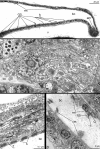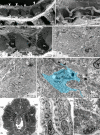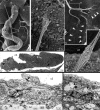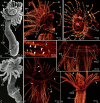Development, organization, and remodeling of phoronid muscles from embryo to metamorphosis (Lophotrochozoa: Phoronida)
- PMID: 23617418
- PMCID: PMC3658900
- DOI: 10.1186/1471-213X-13-14
Development, organization, and remodeling of phoronid muscles from embryo to metamorphosis (Lophotrochozoa: Phoronida)
Abstract
Background: The phoronid larva, which is called the actinotrocha, is one of the most remarkable planktotrophic larval types among marine invertebrates. Actinotrochs live in plankton for relatively long periods and undergo catastrophic metamorphosis, in which some parts of the larval body are consumed by the juvenile. The development and organization of the muscular system has never been described in detail for actinotrochs and for other stages in the phoronid life cycle.
Results: In Phoronopsis harmeri, muscular elements of the preoral lobe and the collar originate in the mid-gastrula stage from mesodermal cells, which have immigrated from the anterior wall of the archenteron. Muscles of the trunk originate from posterior mesoderm together with the trunk coelom. The organization of the muscular system in phoronid larvae of different species is very complex and consists of 14 groups of muscles. The telotroch constrictor, which holds the telotroch in the larval body during metamorphosis, is described for the first time. This unusual muscle is formed by apical myofilaments of the epidermal cells. Most larval muscles are formed by cells with cross-striated organization of myofibrils. During metamorphosis, most elements of the larval muscular system degenerate, but some of them remain and are integrated into the juvenile musculature.
Conclusion: Early steps of phoronid myogenesis reflect the peculiarities of the actinotroch larva: the muscle of the preoral lobe is the first muscle to appear, and it is important for food capture. The larval muscular system is organized in differently in different phoronid larvae, but always exhibits a complexity that probably results from the long pelagic life, planktotrophy, and catastrophic metamorphosis. Degeneration of the larval muscular system during phoronid metamorphosis occurs in two ways, i.e., by complete or by incomplete destruction of larval muscular elements. The organization and remodeling of the muscular system in phoronids exhibits the combination of protostome-like and deuterostome-like features. This combination, which has also been found in the organization of some other systems in phoronids, can be regarded as an important characteristic and one that probably reflects the basal position of phoronids within the Lophotrochozoa.
Figures












Similar articles
-
Organization and metamorphic remodeling of the nervous system in juveniles of Phoronopsis harmeri (Phoronida): insights into evolution of the bilaterian nervous system.Front Zool. 2014 Apr 28;11:35. doi: 10.1186/1742-9994-11-35. eCollection 2014. Front Zool. 2014. PMID: 24847374 Free PMC article.
-
Metamorphic remodeling of morphology and the body cavity in Phoronopsis harmeri (Lophotrochozoa, Phoronida): the evolution of the phoronid body plan and life cycle.BMC Evol Biol. 2015 Oct 21;15:229. doi: 10.1186/s12862-015-0504-0. BMC Evol Biol. 2015. PMID: 26489660 Free PMC article.
-
Hox gene expression during development of the phoronid Phoronopsis harmeri.Evodevo. 2020 Feb 10;11:2. doi: 10.1186/s13227-020-0148-z. eCollection 2020. Evodevo. 2020. PMID: 32064072 Free PMC article.
-
The invention of the pilidium larva in an otherwise perfectly good spiralian phylum Nemertea.Integr Comp Biol. 2010 Nov;50(5):734-43. doi: 10.1093/icb/icq096. Epub 2010 Jul 19. Integr Comp Biol. 2010. PMID: 21558236 Review.
-
Phoronida-A small clade with a big role in understanding the evolution of lophophorates.Evol Dev. 2024 Jul;26(4):e12437. doi: 10.1111/ede.12437. Epub 2023 Apr 29. Evol Dev. 2024. PMID: 37119003 Review.
Cited by
-
Organization and metamorphic remodeling of the nervous system in juveniles of Phoronopsis harmeri (Phoronida): insights into evolution of the bilaterian nervous system.Front Zool. 2014 Apr 28;11:35. doi: 10.1186/1742-9994-11-35. eCollection 2014. Front Zool. 2014. PMID: 24847374 Free PMC article.
-
Thyroid hormone regulates abrupt skin morphogenesis during zebrafish postembryonic development.Dev Biol. 2021 Sep;477:205-218. doi: 10.1016/j.ydbio.2021.05.019. Epub 2021 Jun 3. Dev Biol. 2021. PMID: 34089732 Free PMC article.
-
Hox gene expression in postmetamorphic juveniles of the brachiopod Terebratalia transversa.Evodevo. 2019 Jan 8;10:1. doi: 10.1186/s13227-018-0114-1. eCollection 2019. Evodevo. 2019. PMID: 30637095 Free PMC article.
-
Development and organization of the larval nervous system in Phoronopsis harmeri: new insights into phoronid phylogeny.Front Zool. 2014 Jan 13;11(1):3. doi: 10.1186/1742-9994-11-3. Front Zool. 2014. PMID: 24418063 Free PMC article.
-
Development of the nervous system in Platynereis dumerilii (Nereididae, Annelida).Front Zool. 2017 May 25;14:27. doi: 10.1186/s12983-017-0211-3. eCollection 2017. Front Zool. 2017. PMID: 28559917 Free PMC article.
References
-
- Hejnol A, Obst M, Stamatakis A, Ott M, Rouse GW, Edgecombe GD, Martinez P, Baguñà J, Bailly X, Jondelius U, Wiens M, Müller WEG, Seaver E, Wheeler WC, Martindale MQ, Giribet G, Dunn CW. Assessing the root of bilaterian animals with scalable phylogenomic methods. Proc Biol Sci. 2009;276:4261–4270. doi: 10.1098/rspb.2009.0896. - DOI - PMC - PubMed
-
- Cohen B, Weydmann A. Molecular evidence that phoronids are a subtaxon of brachiopods (Brachiopoda: Phoronata) and that genetic divergence of metazoan phyla began long before the early Cambrian. Organisms, Divers Evol. 2005;5:253–273. doi: 10.1016/j.ode.2004.12.002. - DOI
-
- Temereva EN, Malakhov VV. Embryogenesis in phoronids. Invert Zool. 2012;9(1):1–39.
Publication types
MeSH terms
LinkOut - more resources
Full Text Sources
Other Literature Sources
Molecular Biology Databases

